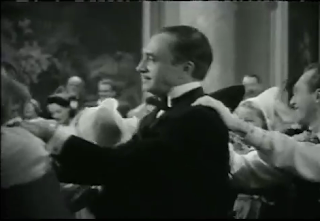It is funny what one can remember about a film one has seen once a long, long time ago. There are moments, flashes that are very clear, but not enough to form a coherent.
One of these films that fits the description is
Man of a Thousand Faces (1957)
, a bio-pic staring James Cagney, who portrays the great silent actor and make-up master Lon Chaney This film is rather special, because not only does it have the honor of being my first Cagney film, but also my cinematic introduction to the works of Chaney himself.
Just for the heck of it, I will see just how accurate these 10+ year old memories of mine are: In this post, I will jot down everything that I remember about the film, (in as close to chronological order that I can muster). I will then watch it for the second time in my life, and see how accurate my memories are.
It starts out in Chaney's childhood. You see him on his way home, it looks like he was in a fight. His young sister chides him, saying that Mama would not be happy. He goes to his mother, and comunicates with her in sign langue, ( one of these gesetures looks like clap). She "talks" with him, and that brings a smile to his face.
When he is an adult, he is in 1919's
The Miracle Man (as I have latter figured out). The scene is filmed in which he is a twisted up criple who crawls towards a prist. The prist lifts his hand, looking holy, and Chaney untwists him self slowly. He emotionally kisses the man's hand. The scene finished, Chaney stands up and procededs to do a little tap dance.
He is married to a woman who obsessed with their baby being born deaf, because of Chaney's parents. The baby's post-birth spanking is shown in silhouette in the hospital, and the wife is at first happy because the baby is crying, but becomes upset when the doctor tells her that crying is not influenced by what he hears.
Later, Chaney stands over the baby's crib, with his wife the background. She has continued to express worry that their son is deaf. Exasperated, he claps his hands loudly, and the baby cries. The parents are relived, and comfort the child.
The wife meets Chaney's parents, and greets them with a shy "hello", but is surprised when she finds out by default that they are deaf. She goes away to cry, and Chaney talks with his mom and she brings a smile to his face, echoing the beginning of the film. He then goes to his wife, and tells him that his Mom was right: that he should have told his wife that they were deaf.
The a filming of the whipping scene in
The Hunchback of Notre Dame (1923) is interrupted by some people, and there is an argument between them and Chaney (while he is still in make-up, which does not look similar to the original film).
The famous unmasking scene from
The Phantom of the Opera (1925) is being filmed. Christine (with long blonde hair, for some reason) is sneaking up behind the masked Phantom, who preoccupied with playing the organ. She removes the mask from behind, and faints with shock when she sees his hideous visage. The Phantom (who has long straight white hair, for some reason) looks down at her still figure, and collapses from grief. After a call of "cut", Chaney and the actress get up, and they walk off while he pats her hand, talking cordially.
Chaney gets remarried to a nice, non-nerotic woman. You know she is nice, because she talks to the parents in sign language and hugs them.
Chaney and his son are talking in sign language at the edge of a dock. His second wife asks what's going on, Chaney says that they are having a "guy talk", and continues to sign.
Chaney is on his deathbed. No longer able to talk, he communicates with sign language. He tells his son to pick him his old make-up box. The son obeys, and Chaney takes out a piece of chalk and adds "Jr." to the end of his name. He smiles, and dies.



















































